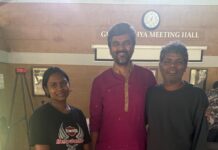
When now-iconic Tamil writer Jeyamohan’s first book was released in 1991, he did not sleep for three days leading up to the launch. He was 29 years old. Now, over 300 books later, on the day his book of short stories, translated into English for the very first time, titled Stories of The True was released, he casually said: “I have crossed the age of excitement.”
For sure, Jeyamohan’s literary life has had more ‘excitement’ than he may have wanted— from refusing the Padma Shri in 2016 on grounds that it would brand him a “Hindutva sympathiser” to being called out for his ‘misogynist’ criticism of women writers in 2014.
Stories of The True is a collection of twelve inspiring and imaginative narratives based on the lives of real people. The book was a breakout success in Tamil when it was first released in 2011 as a series on his website. It includes his famous work ‘Elephant Doctor’, which sold 2 lakh copies when it was released as a book and his favourite story in the collection ‘A Hundred Armchairs’. Jeyamohan said it was the “simplest” of all his books.
Complex mind, simple stories
Jeyamohan is correct. His work ranges from essays critiquing the grand contours of the Indian literary landscape to re-writing a serialised version of Mahabharata on his website. But he maintains that a lot of his writing is inspired by real events. “If you ask me if it is an article or a story, it is somewhere in between,” he said.
In the foreword to Aram, as the Tamil original of Stories of The True was named, he wrote: “The stories in this collection revolve around the central idea of ‘aram’, the Tamil equivalent of the Sanskrit word ‘dharma.’ Driven by a stirring in the depths of my being, I wrote these stories in a heightened state that lasted nearly forty days.”
Jeyamohan began writing the first story of the collection 11 years ago and published it on his website. “The reaction from readers made me realise that everyone shared my mood. Everyone wanted hope.” Then the stories kept coming.
Amongst his most famous stories is the ‘Elephant Doctor’ inspired by a visit to Topslip in the Western Ghats. There, Jeyamohan stayed in the house once occupied by V. Krishnamurthy, a veterinarian popularly known as the ‘Elephant Doctor.’ The story deals with the doctor recommended for a Padma Sri but not conferred one. Jeyamohan thought: When a person has been recognised by elephants, does it really matter if the Indian government recognised him or not? And that’s how the story took shape.
“You asked me why I don’t find the need to promote myself and get my work translated to English,” he said, smiling. “It is the same thing: My mission is to promote Tamil literature and philosophy, which gives me satisfaction. And my elephants are my readers.”
‘Two rebirths’ of Jeyamohan
Born in Kanyakumari district in 1962, life was anything but kind to the writer. Jeyamohan lost both his parents to suicide in 1984, pushing him further into a period of depression and turmoil. At the time, he was working a temporary job in the telephones department in Kasargod, Kerala.
“I have had two rebirths,” he said. After his parents died, Jeyamohan said he set out to kill himself on a railway track. “In the golden light of that morning, I set eyes on a worm resting on a leaf, with a body that glowed as if it was made of light—with a soul made of light. Here was a being for which every moment of this life was of utmost significance,” he wrote in the foreword of Aram.
That was his first rebirth. The second was when he wrote the book of short stories Aram. “At 50, through this book, it was a second rebirth, since then there has been no looking back.”
Jeyamohan dedicates his time to promoting the work of writers who have come before him and thinks of it as “duty” to promote them. His favourite writer is the late Qurratulain Hyder who wrote ‘Aag ka Dariya’. “If I may talk about one personal achievement, it is identifying and mentoring talented women writers. I mentor them and showcase their work on my site.”
Image in a Translator’s mind
Jeyamohan’s success goes beyond the literary sphere. Incidentally, Stories of The True’s translator, Priyamvada Ramkumar, is a Chennai-based private equity investor. “It was the love for his stories that made me translate his work,” she said, “When I started off, I had fidelity to the text, and then it transformed to fidelity to the intent.”
After Ramkumar translated the first few stories in the collection, she took it to Jeyamohan for his feedback. “I did go back to him for a lot of cultural references, there are a lot of details in the work that are rooted in the local culture,” she said. “As a translator, you are translating different readings of the text. Often what you are translating is the image you have constructed in your mind of the text.”
It’s safe to say that Jeyamohan’s new work has everything to make it a success. Sharing roaring feedback to one of his stories titled ‘The Meal Tally’ in Stories of The True, he said that soon after the story was published in Tamil, people wrote in telling him about all the ‘Kethel Sahibs’—pay-as-you-can eateries—across Tamil Nadu.
To date, his inbox floods with emails whose subject line reads: “There is a Kethel Sahib in my town.”
(Edited by Srinjoy Dey)
courtesy











